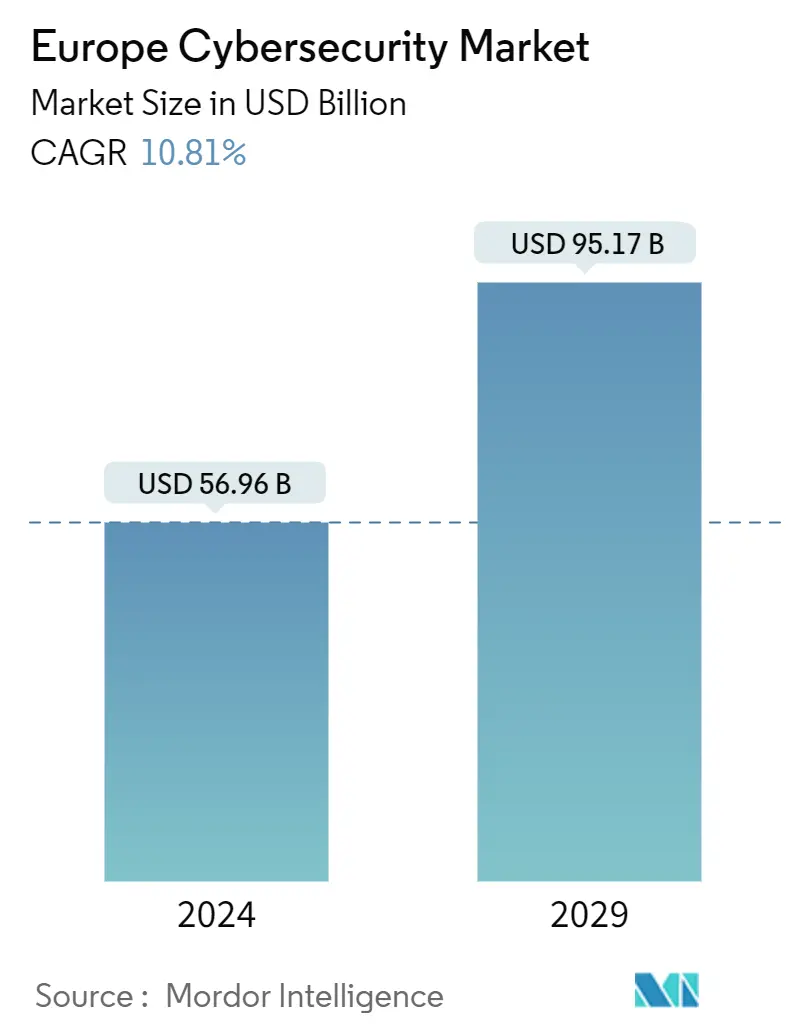Market Size of Europe Cybersecurity Industry

| Study Period | 2019 - 2029 |
| Base Year For Estimation | 2023 |
| Market Size (2024) | USD 56.96 Billion |
| Market Size (2029) | USD 95.17 Billion |
| CAGR (2024 - 2029) | 10.81 % |
| Market Concentration | Low |
Major Players
*Disclaimer: Major Players sorted in no particular order |
Europe Cybersecurity Market Analysis
The Europe Cybersecurity Market size is estimated at USD 56.96 billion in 2024, and is expected to reach USD 95.17 billion by 2029, growing at a CAGR of 10.81% during the forecast period (2024-2029).
The key drivers contributing to the increase in the adoption of data-intensive approaches and decisions with the growth include the rise in the number of cyber-attacks regionally with the growing digitalization has the potential to damage the internet-linked digital infrastructure of various government or private sector enterprises, thereby significantly driving the market growth rate.
- The pandemic raised the demand for cybersecurity solutions to protect businesses and countries from malicious cyber attacks supported by increasing digitalization. Additionally, the Bank for International Settlements stated that, during the pandemic, financial institutions faced an increasing risk of cyber attacks, which were accelerated by remote working conditions. The need for cyber security majors in enterprises and government entities of various countries increased in the post-pandemic time due to the trend of online and data-driven businesses, fueling the implementation of cybersecurity solutions.
- According to a European DIGITAL SME Alliance report released in October 2023, a marked increase in ransomware attacks was reported, followed by phishing campaigns carried out over the same period each year, mainly targeting France, Germany, Italy, and Spain. In all four quarters, there was a consistent peak in attacks during the first quarter of 2023, with 7,772 new Common Vulnerabilities and Exposures being released, highlighting yet again the constantly changing and dynamic nature of cyber vulnerability.
- Digital connectivity has become a fundamental aspect of life in today's constantly evolving world. It is the key to communication, commerce, and access to information in this age. To ensure equal opportunities for all individuals and communities, it is therefore essential to prioritize investments in digital connectivity. According to new research by the UK government, superfast broadband is available to 98% of households in urban areas, compared to 86% in rural areas.
- The increasing integration of digital technologies into critical infrastructure, such as energy grids, transportation systems, and healthcare facilities, has significantly intensified the potential damages from cyber attacks. As these vital systems become more interconnected and reliant on digital platforms, they become more susceptible to malicious activities that can disrupt operations, compromise sensitive data, and even pose risks to public safety. This intensified vulnerability necessitates a robust and adaptive cybersecurity ecosystem to safeguard against potential consequences.
- However, the increasing demand for cyber security solutions in a shorter period has raised the skill gap in the cyber security market among the workforce, restricting the market adoption during the forecast period because, without a presence of professional cyber security professionals, companies cannot implement the cyber security solution in their systems effectively.
- With the outbreak of COVID-19, the cloud market gained significant traction as cloud-based services and tools are increasingly adopted due to organizations deploying remote work access amid lockdowns in various countries, as indicated in the graph. With the growing trends of cloud adoption and ongoing migration of on-premise to cloud solutions, cyberattacks and threats have also increased considerably, fueling the market growth rate. The end-user cloud adoption scope expanded by the COVID-19 outbreak also fueled investment in the market. Many start-ups in the market have gained investments in recent months, which is also expected to fuel innovation in the coming years.
Europe Cybersecurity Industry Segmentation
Cybersecurity solutions help an organization monitor, detect, report, and counter cyber threats that are internet-based attempts to damage or disrupt information systems and hack critical information using spyware, malware, and phishing to maintain data confidentiality. The study is structured to track the revenues accrued by cybersecurity vendors through sales of various solutions and allied services.
The Report Covers European Cyber Security Companies. The Market is Segmented by Offering (Security Type (Cloud Security, Data Security, Identity Access Management, Network Security, Consumer Security, Infrastructure Protection, and Other Security Types), Services), Deployment (Cloud and On-premise), End-user Industry (BFSI, Healthcare, Manufacturing, Government and Defense, IT and Telecommunication, and Other End-user Industries), and Country (Germany, United Kingdom, France, Spain, Italy, Netherlands, and the Rest of Europe). The Report Offers Market Sizes and Forecasts in Value (USD) for all the Above Segments.
| By Offering | |||||||||
| |||||||||
| Services |
| By Deployment | |
| Cloud | |
| On-premise |
| By End-user Industry | |
| BFSI | |
| Healthcare | |
| Manufacturing | |
| Government and Defense | |
| IT and Telecommunication | |
| Other End-user Industries |
| By Country | |
| Germany | |
| United Kingdom | |
| France | |
| Spain | |
| Italy | |
| Netherlands | |
| Rest of Europe |
Europe Cybersecurity Market Size Summary
The European cybersecurity market is poised for significant growth, driven by the increasing frequency of cyber-attacks and the rapid digitalization across the region. The rise in cyber threats, such as ransomware and phishing attacks, particularly in countries like France, Germany, Italy, and Spain, underscores the urgent need for robust cybersecurity measures. The integration of digital technologies into critical infrastructure sectors, including energy, transportation, and healthcare, has heightened the vulnerability of these systems to cyber threats, necessitating a strong cybersecurity framework. The COVID-19 pandemic further accelerated the demand for cybersecurity solutions as businesses and governments shifted to remote work and digital operations, highlighting the importance of safeguarding digital assets. The market is characterized by a competitive landscape with major global players like IBM, Cisco, and Palo Alto Networks actively expanding their presence through strategic partnerships and acquisitions.
The United Kingdom faces a complex cyber threat landscape, with increasing attacks on both public and private sectors, prompting a proactive approach to cybersecurity. Regulatory frameworks such as GDPR drive the adoption of cybersecurity solutions, while collaborations between government and telecom companies aim to enhance security standards. The growing demand for cybersecurity in the IT and telecom sectors, coupled with the rise of cloud-based services, fuels market growth. Investments in advanced cybersecurity solutions are essential to mitigate risks and protect against cyber threats. The European market is further supported by initiatives from the European Commission, including funding for cloud security projects and the adoption of cybersecurity certification schemes, which collectively aim to strengthen the region's cybersecurity posture.
Europe Cybersecurity Market Size - Table of Contents
-
1. MARKET INSIGHTS
-
1.1 Market Overview
-
1.2 Industry Attractiveness - Porter's Five Forces Analysis
-
1.2.1 Bargaining Power of Suppliers
-
1.2.2 Bargaining Power of Consumers
-
1.2.3 Threat of New Entrants
-
1.2.4 Competitive Rivalry Within the Industry
-
1.2.5 Threat of Substitutes
-
-
1.3 Assessment of the Impact of COVID-19 on the Market
-
-
2. MARKET SEGMENTATION
-
2.1 By Offering
-
2.1.1 Security Type
-
2.1.1.1 Cloud Security
-
2.1.1.2 Data Security
-
2.1.1.3 Identity Access Management
-
2.1.1.4 Network Security
-
2.1.1.5 Consumer Security
-
2.1.1.6 Infrastructure Protection
-
2.1.1.7 Other Security Types
-
-
2.1.2 Services
-
-
2.2 By Deployment
-
2.2.1 Cloud
-
2.2.2 On-premise
-
-
2.3 By End-user Industry
-
2.3.1 BFSI
-
2.3.2 Healthcare
-
2.3.3 Manufacturing
-
2.3.4 Government and Defense
-
2.3.5 IT and Telecommunication
-
2.3.6 Other End-user Industries
-
-
2.4 By Country
-
2.4.1 Germany
-
2.4.2 United Kingdom
-
2.4.3 France
-
2.4.4 Spain
-
2.4.5 Italy
-
2.4.6 Netherlands
-
2.4.7 Rest of Europe
-
-
Europe Cybersecurity Market Size FAQs
How big is the Europe Cybersecurity Market?
The Europe Cybersecurity Market size is expected to reach USD 56.96 billion in 2024 and grow at a CAGR of 10.81% to reach USD 95.17 billion by 2029.
What is the current Europe Cybersecurity Market size?
In 2024, the Europe Cybersecurity Market size is expected to reach USD 56.96 billion.

